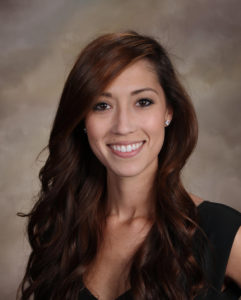
Juli Cackovic (B.S. ’13) majored in food science and human nutrition with a concentration in nutritional science and dietetics. In May of 2015, she finished a Master of Science in biomedical sciences at Midwestern University in Glendale, Arizona, with her research thesis on dopaminergic mitochondrial gene mutation in Parkinson’s Disease. In May of 2019, she graduated from the Midwestern University Arizona College of Osteopathic Medicine in Glendale and is currently a second-year family medicine resident, as well as chief resident in her program at Medical City Fort Worth in Fort Worth, Texas. She plans to work as a hospitalist after finishing residency training. To learn more about Juli and her current position, read her interview below.
Describe your current position and some of the responsibilities that come with it.
I am currently a PGY-2, or second year, family medicine resident. Residency is the last mandatory step of training required to become a board certified physician. Family medicine residency consists of three years of training in both the inpatient and outpatient setting, including rotations through multiple different subspecialties. As a resident you are responsible for learning all of the ins and outs of your specific area of focus and applying the knowledge you learned as a medical student to actual patient care. For family medicine, the scope and practice is very broad, as we work with all age ranges and can care for patients in the ambulatory and hospital setting. My ultimate goal is to become a hospitalist after finishing residency.
How has COVID-19 changed operations for your company and industry, and how are you responding to it?
The changes that we are seeing in health care are still evolving as we learn more about COVID, however it has affected how we interact with patients in both the hospital and outpatient setting. In the hospital, precautions are being taking to keep providers, staff, hospital employees as well as the patients we see safe. In the outpatient setting, similar precautions are also being taken with face-to-face patient encounters. There has also been an increase in the utilization of telemedicine, where patients can have visits with providers done over the phone or with the use of video. In our resident clinic, as with most outpatient clinics, telehealth visits will be a permanent part of ambulatory care.
Why did you decide to pursue your current career path?
I didn’t always know I wanted to go into medicine but I did always know that I wanted to work with people. Medicine gave me a path to include the knowledge from both my undergraduate degree as well as my master’s degree with the added benefit of being very fulfilling work where I feel like I am making a positive impact every day. It sounds very hallmark card when you spell it out, but honestly it is a big perk. Spending the majority of your 20s on your education you learn a lot about yourself and your motivations in life. For me, I wanted a career where I was always moving, always learning, and always dealing with something a little different every day. Family medicine provides that for me, with a lot of options and diversity in the patient base I will see as well as will give me a little more flexibility with lifestyle outside of medicine, once I finish residency, of course.
How have your education and experiences at CSU helped you in your career? Was there a faculty member in the College of Health and Human Sciences that inspired you most?
CSU was where my future really started to shape, whether I knew it or not at the time. The clubs and leadership opportunities I was fortunate to be a part of as an undergraduate student helped start developing skills I would later use in leadership roles throughout my master’s and medical school and now as Chief Resident of my residency program. Studying nutrition was my first exposure to health care and ultimately set in motion the path that led me to family medicine, because it’s where I felt I could best integrate the knowledge and importance of diet and preventative care into the practice of medicine. David Sampson was my adviser while I was at CSU and it was from him that I first heard about Osteopathic Medicine as an option for pursuing medical education. So thanks, Dr. Sampson! You pointed me in the right direction! Overall, the Food Science and Human Nutrition department is full of many wonderful faculty members I had the privilege to learn from during my time at CSU.
What advice do you have for students looking for a full-time job in your field?
Never let anyone tell you that there is only one track to get into medical school. Everyone’s path is a little different and that’s okay, and frankly how it should be. If you are willing to work hard and put in the time, you can get there. It’s a tough road, but 100% worth it.
The Department of Food Science and Human Nutrition is a part of CSU’s College of Health and Human Sciences.